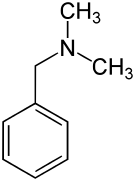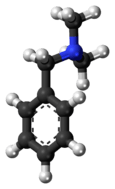Dimethylbenzylamine
Dimethylbenzylamine is the organic compound with the formula C6H5CH2N(CH3)2. The molecule consists of a benzyl group, C6H5CH2, attached to a dimethylamino functional group. It is a colorless liquid. It is used as a catalyst for the formation of polyurethane foams and epoxy resins.
| |||
| Names | |||
|---|---|---|---|
| IUPAC name
N,N-dimethyl-1-phenylmethanamine | |||
| Other names
N,N-Dimethylbenzenemethanamine, N,N-Dimethylbenzylamine, N-Benzyldimethylamine, Dimethylbenzylamine, Benzyl-N,N-dimethylamine, N-(Phenylmethyl)dimethylamine, BDMA, Sumine 2015, Benzenemethanamine, Dabco B-16, Araldite accelerator 062, N,N-Dimethyl(phenyl)methanamine | |||
| Identifiers | |||
3D model (JSmol) |
|||
| ChEMBL | |||
| ChemSpider | |||
| ECHA InfoCard | 100.002.863 | ||
| EC Number |
| ||
PubChem CID |
|||
| UNII | |||
CompTox Dashboard (EPA) |
|||
| |||
| |||
| Properties | |||
| C9H13N | |||
| Molar mass | 135.210 g·mol−1 | ||
| Appearance | colourless liquid | ||
| Density | 0.91 g/cm3 at 20 °C | ||
| Melting point | −75 °C (−103 °F; 198 K) | ||
| Boiling point | 180 to 183 °C (356 to 361 °F; 453 to 456 K) | ||
| 1.2 g/100mL | |||
| Hazards | |||
| R-phrases (outdated) | R10, R20, R21, R22, R34, R52, R53 | ||
| S-phrases (outdated) | S26, S36, S45, S61 | ||
| NFPA 704 (fire diamond) | |||
| Flash point | 55 °C (131 °F; 328 K) | ||
| 410 °C (770 °F; 683 K) | |||
Except where otherwise noted, data are given for materials in their standard state (at 25 °C [77 °F], 100 kPa). | |||
| Infobox references | |||
Synthesis
N,N-Dimethylbenzylamine can be synthesized by the Eschweiler–Clarke reaction of benzylamine [1][2]
Reactions
It undergoes directed ortho metalation with butyl lithium:
- [C6H5CH2N(CH3)2 + BuLi → 2-LiC6H4CH2N(CH3)2
- LiC6H4CH2N(CH3)2 + E+ → 2-EC6H4CH2N(CH3)2
Via these reactions, many derivatives are known with the formula 2-X-C6H4CH2N(CH3)2 (E = SR, PR2, etc.).
The amine is basic and undergoes quaternization with alkyl halides (eg hexyl bromide) to give quaternary ammonium salts:[3]
- [C6H5CH2N(CH3)2 + RX → [C6H5CH2N(CH3)2R]+X−
Such salts are useful phase transfer catalysts.
References
- Icke, R. N.; Wisegarver, B. B.; Alles, G. A. (1945). "β-Phenylethyldimethylamine". Organic Syntheses. 25: 89. doi:10.15227/orgsyn.025.0089.
- Clarke, H. T.; Gillespie, H. B.; Weisshaus, S. Z. (1933). "The Action of Formaldehyde on Amines and Amino Acids". J. Am. Chem. Soc. 55 (11): 4571. doi:10.1021/ja01338a041.
- W. R. Brasen, C. R. Hauser (1954). "o-Methylethylbenzyl Alcohol". Org. Synth. 34: 58. doi:10.15227/orgsyn.034.0058.CS1 maint: uses authors parameter (link)
External links
This article is issued from Wikipedia. The text is licensed under Creative Commons - Attribution - Sharealike. Additional terms may apply for the media files.


